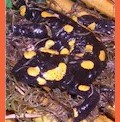Determining what salamanders eat is very important most especially if you want to keep some at home. Salamanders are very fragile creatures and feeding them with inappropriate food can lead them to various illnesses, and worse - death. Thus, if you want to get pet salamanders, make sure that you can provide them with proper nutrition so they can fully grow and develop into healthy salamanders.
Often, the food preferences of salamanders vary if they are young or old. Keep in mind that larvae and young adult salamanders may eat different foods from those of their adult versions. Usually, larvae salamanders eat smaller types of food than the adult salamanders.
Three to six-week old salamanders prefer to eat tubifex, sludge worm or perhaps mosquito larva. Since they are aquatic salamanders they also feed on aquatic invertebrates. Once they reach the age of six to eight-weeks old, they are ready to consume salamander foods regularly taken by adult salamanders.
Salamanders at a very young age that did not adapt well in land prefer to eat maggots and rainworms, as well as the foods that were mentioned above. For those salamanders that are well adapted in land can eat flies, spiders and other insects.
The diet of every salamander may vary from one species to another, just like how various breeds of cats and dogs differ on their food preferences. If you own a particular species of salamander, you need to be accurate when giving them the right nutrition.
Spotted salamanders prefer crickets, centipedes, spiders and worms. Another example is the Redback salamander. They love to munch small insects and invertebrates. Most of the time, they find their foods on trees. Blue-spotted salamanders take the pleasure on eating pills, potato bugs and earthworms. Terrestrial and arboreal salamanders can also eat crawling insects such as moths, millipedes, aphids and beetles.
Although salamanders feed on various foods, one thing is similar about them. They are carnivores in nature. Thus, it is important to feed them only with animal tissues. They won’t surely eat plants and other kinds of meal apart from small insects, worms and crustaceans.
Whenever you are feeding your salamanders, prefer feeding them with live foods. The movement of live worms or insects can put them in an alert position, which signals that prey is nearby. Also, be careful not to put carnivorous insects inside a salamander tank with larvae. Those insects may surely feed on the larvae even before the salamander can eat them.
Make sure that you are giving the right amount of food every meal. Some salamanders actually get obese due to overfeeding. When your salamanders are not hibernating, try to give them additional supplements like vitamins. You can give this in powder form and coat their food with the vitamins before putting it inside their tank.
Furthermore, be prepared to feed your salamanders with live prey. Perhaps you can grow your own insects so you don’t need to buy their foods outside. You can even raise small fishes like guppies for your aquatic salamanders.
The most important thing to keep in mind when feeding salamanders is to give them fresh and healthy foods. Always keep in mind to make an extensive research on the type of salamanders you want to own in your house since this will be the basis on how you can feed them.
